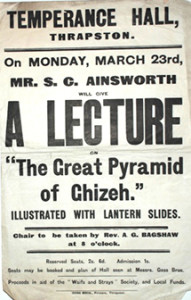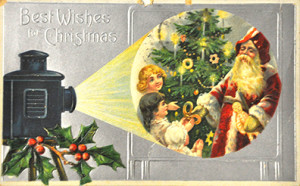Luckily the 18th and 19th centuries were awash with paper items designed to inform, entertain and amuse people. Today a treasure trove of material concerning and illustrating the magic lantern may be found in such ephemeral material as letters, posters, broadsides, postcards, programs, trade cards, trade catalogues, tickets, sheet music, business cards, advertisements, newspapers and magazines. For instance, the Richard Balzer Collection includes a letter dated 1826 from a the head of a school in Richmond, Virginia to a friend in Philadelphia, inquiring if his friend would be kind enough to purchase a Phantasmagoria Lanthorn either from McAllister Brothers or elsewhere in town as well as five sliders. The letter’s author seems well informed of the going prices, mentioning that he expected the Lanthorn to be priced at $13.25 and each slide to be $1.25.
Newspapers often carried advertisements for lantern sales and announcements of lantern shows, giving information on showmen, locations, dates, times and cost. The Balzer Collection includes a copy of the 1804 Boston Gazette with an advertisement that boldly states FOR THE SECOND TIME IN BOSTON—PHANTASMAGORIA. It advertises a show by William Bates at the Columbian Museum on June 25th at the cost of 50 cents. The first known record of a Phantasmagoria show in America is in New York in 1803, five years after Etienne-Gaspard Robertson brought his Phantasmagoria show to Paris.

Broadsides are an excellent source for historical information and often feature strong graphics and interesting illustrations. Single-sided broadsides advertised shows with such wonderful titles as: The Original Phantasmagoria, The Great Pyramids Of Ghizeh, Grand Magic Lantern Exhibition, Miller’s Grand Original Sciopticon Entertainment, Pittman’s Dissolving Views or Denton’s Illustrated Lecture.
Trade catalogues are a rich source of information about magic lanterns. Lantern firms such as McAllister, Marcy, James Queen, Theo Harbach, A.T. Thompson, Newton & Co, Charles Bessler, James How and J.B. Colt produced annual volumes advertising their wares with illustrated descriptions of single, biunnial and triunnial lanterns; stationary, moving and special effect slides; and screens, illuminants and lecturer lamps for shows. The most readily available catalogues are from the 1880s and 1890s.

One of the most modest yet most colorful forms of ephemera is the postcard, a late 19th century creation that began as a simple blank card for sending messages. Soon more of the card’s space was occupied by photographs and colorful chromolithographic images. By the turn of the 20th century millions of cards were posted around the world. The magic lantern graced many cards. Closely related to the postcard were trade cards, given away by shops with their advertising on one side and some illustration they thought customers would find interesting or appealing on the other—often the magic lantern.
Although this material was not produced to endure, much of it is still available, relatively inexpensive, and easily found on eBay.